A Reliable Prediction Algorithm Based on Genre2Vec for Item-Side Cold-Start Problems in Recommender Systems with Smart Contracts
Abstract
1. Introduction
- We propose a method to predict the representative score of a new item by utilizing the metadata of the item: category information.
- We treat the history of the item selected by the users as a document and the category of each item as a word. Subsequently, by applying skip-gram based on the user’s item history, we could vectorize the category information like done under word2vec.
- Based on Genre2vec, predictive scores can be derived using the vectors derived in this manner and the categories of new items.
- The proposed method allows us to alleviate the cold-start problem faced when new items are introduced. By applying the concept of CBF to CF, the recommendation accuracy in existing recommender systems can be improved.
- We proved that the proposed approach outperforms the conventional collaborative filtering-based approaches: the proposed approach was 33.3% more accurate than memory- and model-based CF in terms of mean absolute error (MAE) in best cases.
- We propose data processing systems based on the concept of blockchain and smart contracts for improving the reliability of recommendation processes.
2. Related Work
2.1. Item-Side Cold-Start Problems in Recommender Systems
Item-Side Cold-Start Problems
2.2. Word Embedding for Recommender Systems
2.3. Blockchain and Smart Contracts
2.4. Background
2.5. Analysis and Motivation
3. Proposed Approach
3.1. Generation of Users’ Category Selection Vector
3.2. Generation of Genre2vec Using Concept of Word Embedding
3.3. Predicting Average Preference of a New Item
| Algorithm 1 Predicting an average rating of a new item through Genre2vec |
| Require: CRM = Category rating map C2V = Category vector NCL = category list (category combination) of new item sim (c1, c2) = cosine similarity between c1 and c2 1: function predictAverageRating(CRM, C2V, NCL) 2: temp1 = 0 3: for c in NCL do 4: temp2 = 0 5: for cc in NCL do 6: if c ≠ cc then 7: temp2 + = CRM[c] * sim(C2V[c], C2V[cc]) 8: end if 9: end for 10: temp1 + = temp2 11: end for 12: average = temp1/size(NCL) 13: return average 14: end function |
3.4. Recommendation Management Systems Based on Smart Contract
4. Experiments
4.1. Database
4.2. Experimental Process
4.2.1. Results of Genre2vec Based on MovieLens Dataset
4.2.2. CF Approaches Used in Experiments
4.2.3. Experimental Design
4.3. Experimental Results
4.4. Constructing a Smart Contract System
- Private Ethereum Network Environment
- All content providers have one wallet
- If the recommendation result provided to the user matches the result stored in the blockchain network, the content provider receives 1 ETH by smart contract
- The reliability of the content provider is calculated as (the number of ETH)/(the number of recommendations)
| Algorithm 2 Smart contract to calculate a reliability score for a content provider |
| Require: Input = the set of input data by a user in blockchain network Output = the set of the recommendation results for a user in blockchain network REC_IN = the set of input data for the recommendation result REC_OUT = the set of recommendation result by an algorithm 1: function calReliabilityScore(INPUT, OUTPUT, REC_IN, REC_OUT) 2: cnt = 0 3: eth = 0 4: for i in range (0, size(INPUT)) do 5: if (INPUT[i] = REC_IN[i]) and (OUTPUT[i] = REC_OUT[i]) then 6: eth += 1 7: end if 8: cnt += 1 9: end for 10: reliability_score = eth/cnt 11: return reliability_score 12: end function |
5. Conclusions
- We have proposed Genre2vec by vectorizing category information.
- We have proposed the learning model by applying the concept of Word2Vec for vectorizing category information.
- We have demonstrated that the prediction results based on Genre2vec are more precise than those of conventional CF approaches.
- Comparing the worst case (KNN-Basic) among the conventional CF techniques and the results of the proposed method, the proposed method shows about 25% better results.
- Comparing the best case (SVD) among the conventional CF techniques and the results of the proposed method, the proposed method shows about 19% better results.
- Based on our approach, we have alleviated item-side cold-start problems in recommender systems.
- In addition, we have implemented the blockchain system with smart contracts that address the recommendation processes in the item-side cold-start situation to improve content reliability.
- In the case of web or mobile applications such as e-commerce or media content recommendation services, the items have metadata such as category. In this case, our approach can be applied to these domains.
- Furthermore, based on the vectorization of metadata, we can derive a higher prediction accuracy than the existing input for the aspect of the average ratings.
- Through our approach, it is possible to provide more reliable recommendation results than conventional CF approaches for a new item to online service users.
- In addition, online service providers can build more reliable recommender systems in cold-start situations for a new item.
- Through the structure for blockchain smart contracts, e-commerce and media-services on the web can provide more reliable contents.
Author Contributions
Funding
Institutional Review Board Statement
Informed Consent Statement
Data Availability Statement
Conflicts of Interest
References
- Sarwar, B.M.; Karypis, G.; Konstan, J.A.; Riedl, J. Item-based Collaborative Filtering Recommendation Algorithms. In Proceedings of the 10th International World Wide Web Conference WWW ’01, Hong Kong, China, 1–5 May 2001; pp. 285–295. [Google Scholar]
- Choi, S.M.; Ko, S.K.; Han, Y.S. A movie recommendation algorithm based on genre correlations. Expert Syst. Appl. 2012, 39, 8079–8085. [Google Scholar] [CrossRef]
- Okura, S.; Tagami, Y.; Ono, S.; Tajima, A. Embedding-based News Recommendation for Millions of Users. In Proceedings of the 23rd ACM SIGKDD International Conference on Knowledge Discovery and Data Mining KDD ’17, Halifax, NS, Canada, 13–17 August 2017; pp. 1933–1942. [Google Scholar]
- Ratner, A.; Bach, S.H.; Ehrenberg, H.R.; Fries, J.A.; Wu, S.; Ré, C. Snorkel: Rapid Training Data Creation with Weak Supervision. PVLDB 2017, 11, 269–282. [Google Scholar] [CrossRef]
- Peng, F.; Lu, X.; Ma, C.; Qian, Y.; Lu, J.; Yang, J. Multi-level preference regression for cold-start recommendations. Int. J. Mach. Learn. Cybern. 2018, 9, 1117–1130. [Google Scholar] [CrossRef]
- Althbiti, A.; Alshamrani, R.; Alghamdi, T.; Lee, S.; Ma, X. Addressing Data Sparsity in Collaborative Filtering Based Recommender Systems Using Clustering and Artificial Neural Network. In Proceedings of the 2021 IEEE 11th Annual Computing and Communication Workshop and Conference (CCWC), Las Vegas, NV, USA, 27–30 January 2021; pp. 0218–0227. [Google Scholar]
- Jiang, B.; Yang, J.; Qin, Y.; Wang, T.; Wang, M.; Pan, W. A Service Recommendation Algorithm Based on Knowledge Graph and Collaborative Filtering. IEEE Access 2021, 9, 50880–50892. [Google Scholar] [CrossRef]
- Zhao, W.; Tian, H.; Wu, Y.; Cui, Z.; Feng, T. A New Item-Based Collaborative Filtering Algorithm to Improve the Accuracy of Prediction in Sparse Data. Int. J. Comput. Intell. Syst. 2022, 15, 15. [Google Scholar] [CrossRef]
- Rendle, S.; Freudenthaler, C.; Gantner, Z.; Schmidt-Thieme, L. BPR: Bayesian Personalized Ranking from Implicit Feedback. arXiv 2009, arXiv:1205.2618. [Google Scholar]
- Wen, H.; Fang, L.; Guan, L. A hybrid approach for personalized recommendation of news on the Web. Expert Syst. Appl. Int. J. 2012, 39, 5806–5814. [Google Scholar] [CrossRef]
- Chen, X.; Chen, H.; Xu, H.; Zhang, Y.; Cao, Y.; Qin, Z.; Zha, H. Personalized Fashion Recommendation with Visual Explanations based on Multimodal Attention Network: Towards Visually Explainable Recommendation. In Proceedings of the 42nd International ACM SIGIR Conference on Research and Development in Information Retrieval, Paris, France, 21–25 July 2019; pp. 765–774. [Google Scholar]
- Chen, S.; Huang, L.; Lei, Z.; Wang, S. Research on personalized recommendation hybrid algorithm for interactive experience equipment. Comput. Intell. 2020, 36, 1348–1373. [Google Scholar] [CrossRef]
- East, R.; Hammond, K.; Lomax, W.; Robinson, H. What is the Effect of a Recommendation? Mark. Rev. 2005, 5, 145–157. [Google Scholar] [CrossRef]
- Covington, P.; Adams, J.; Sargin, E. Deep Neural Networks for YouTube Recommendations. In Proceedings of the 10th ACM Conference on Recommender Systems RecSys 16, Boston, MA, USA, 15–19 September 2016; pp. 191–198. [Google Scholar]
- Gomez-Uribe, C.A.; Hunt, N. The Netflix Recommender System: Algorithms, Business Value and Innovation. ACM Trans. Manag. Inf. Syst. 2016, 6, 1–19. [Google Scholar] [CrossRef]
- Song, Y.; Dixon, S.; Pearce, M.T. A Survey of Music Recommendation Systems and Future Perspectives. In Proceedings of the 9th International Symposium on Computer Music Modelling and Retrieval (CMMR), London, UK, 19–22 June 2012; pp. 395–410. [Google Scholar]
- van den Oord, A.; Dieleman, S.; Schrauwen, B. Deep content-based music recommendation. In Proceedings of the Advances in Neural Information Processing Systems NIPS ‘13, Lake Tahoe, NV, USA, 5 December 2013; Volume 26, pp. 2643–2651. [Google Scholar]
- Li, J.; He, Z.; Cui, Y.; Wang, C.; Chen, C.; Yu, C.; Zhang, M.; Liu, Y.; Ma, S. Towards Ubiquitous Personalized Music Recommendation with Smart Bracelets. Proc. ACM Interact. Mob. Wearable Ubiquitous Technol. 2022, 6, 1–34. [Google Scholar] [CrossRef]
- Herlocker, J.L.; Konstan, J.; Borchers, A.; Riedl, J. An Algorithm Framework for Peforming Collaborative Filtering. In Proceedings of the 22nd Annual International ACM SIGIR Conference on Research and Development in Information Retrieval SIGIR ’99, Berkeley, CA, USA, 15–19 August 1999; pp. 230–237. [Google Scholar]
- Tkalcic, M.; Odic, A.; Kosir, A.; Tasic, J.F. Affective Labeling in a Content-Based Recommender System for Images. IEEE Trans. Multimed. 2013, 15, 391–400. [Google Scholar] [CrossRef]
- Ricci, F.; Rokach, L.; Shapira, B.; Kantor, P.B. Recommender Systems Handbook; Springer-Verlag: Berlin/Heidelberg, Germany, 2010. [Google Scholar]
- Koren, Y.; Bell, R.M.; Volinsky, C. Matrix Factorization Techniques for Recommender Systems. IEEE Comput. 2009, 42, 30–37. [Google Scholar] [CrossRef]
- de Campos, L.; Fernández-Luna, J.; Huete, J.; Rueda-Morales, M. Combining content-based and collaborative recommendations: A hybrid approach based on Bayesian networks. Int. J. Approx. Reason. 2010, 51, 785–799. [Google Scholar] [CrossRef]
- Cano, E.; Morisio, M. Hybrid Recommender Systems: A Systematic Literature Review. Intell. Data Anal. 2019, 21, 1487–1524. [Google Scholar] [CrossRef]
- Javed, U.; Shaukat, K.; Hameed, I.A.; Iqbal, F.; Alam, T.M.; Luo, S. A Review of Content-Based and Context-Based Recommendation Systems. Int. J. Emerg. Technol. Learn. (Ijet) 2021, 16, 274–306. [Google Scholar] [CrossRef]
- He, X.; Liao, L.; Zhang, H.; Nie, L.; Hu, X. Neural Collaborative Filtering. In Proceedings of the 26th International Conference on World Wide Web WWW 17, Perth, Australia, 3–7 April 2017; pp. 173–182. [Google Scholar]
- Liang, D.; Krishnan, R.G. Variational Autoencoders for Collaborative Filtering. In Proceedings of the 2018 World Wide Web Conference WWW 18, Lyon, France, 10 April 2018; pp. 689–698. [Google Scholar]
- Duong, T.N.; Vuong, T.A.; Nguyen, D.M.; Dang, Q.H. Utilizing an Autoencoder-Generated Item Representation in Hybrid Recommendation System. IEEE Access 2020, 8, 75094–75104. [Google Scholar] [CrossRef]
- Barkan, O.; Koenigstein, N. Item2Vec: Neural Item Embedding for Collaborative Filtering. In Proceedings of the 26th International Workshop on Machine Learning for Signal Processing (MLSP), Salerno, Italy, 13–16 September 2016. [Google Scholar]
- Chen, C.; Wang, C.; Tsai, M.; Yang, Y. Collaborative Similarity Embedding for Recommender Systems. In Proceedings of the World Wide Web Conference WWW 2019, San Francisco, 13–17 May 2019; pp. 637–2643. [Google Scholar]
- Zhao, X.; Liu, H.; Liu, H.; Tang, J.; Guo, W.; Shi, J.; Wang, S.; Gao, H.; Long, B. AutoDim: Field-aware Embedding Dimension Searchin Recommender Systems. In Proceedings of the WWW ’21: The Web Conference 2021, Ljubljana, Slovenia, 19–23 April 2021; pp. 3015–3022. [Google Scholar]
- Rendle, S.; Krichene, W.; Zhang, L.; Anderson, J.R. Neural Collaborative Filtering vs. Matrix Factorization Revisited. In Proceedings of the RecSys 2020: Fourteenth ACM Conference on Recommender Systems, Online, 22–26 September 2020; pp. 240–248. [Google Scholar]
- Schein, A.I.; Popescul, A.; Ungar, L.H.; Pennock, D.M. Methods and metrics for cold-start recommendations. In Proceedings of the 25th Annual International ACM SIGIR Conference on Research and Development in Information Retrieval SIGIR ’02, Tampere, Finland, 11–15 August 2002; pp. 253–260. [Google Scholar]
- Ishikawa, M.; Géczy, P.; Izumi, N.; Morita, T.; Yamaguchi, T. Information Diffusion Approach to Cold-Start Problem. In Proceedings of the 2007 IEEE/WIC/ACM International Conference on Web Intelligence and International Conference on Intelligent Agent Technology-Workshops WI-IAT ’07, Fremont, CA, USA, 2–5 November, 2007; pp. 129–132. [Google Scholar]
- Said, A.; Jain, B.; Narr, S.; Plumbaum, T. Users and Noise: The Magic Barrier of Recommender Systems. In Proceedings of the 20th International Conference on User Modeling, Adaptation, and Personalization, Montreal, QC, Canada, 16–20 July 2012; pp. 237–248. [Google Scholar]
- Bellogín, A.; Said, A.; de Vries, A. The Magic Barrier of Recommender Systems–No Magic, Just Ratings. In Proceedings of the International Conference on User Modeling, Adaptation, and Personalization UMAP 2014, Aalborg, Denmark, 7–11 July 2014; pp. 25–36. [Google Scholar]
- Sarwar, B.M.; Karypis, G.; Konstan, J.A.; Riedl, J. Analysis of recommendation algorithms for e-commerce. In Proceedings of the 2nd ACM Conference on Electronic Commerce EC ’00, Minneapolis, MN, USA, 17–20 October 2000; pp. 158–167. [Google Scholar]
- Bell, R.M.; Koren, Y. Lessons from the Netflix prize challenge. SIGKDD Explor. 2007, 9, 75–79. [Google Scholar] [CrossRef]
- Levy, O.; Goldberg, Y. Neural Word Embedding as Implicit Matrix Factorization. In Proceedings of the Advances in Neural Information Processing Systems 27: Annual Conference on Neural Information Processing Systems, Montreal, QC, Canada, 8–13 December 2014; pp. 2177–2185. [Google Scholar]
- Wei, K.; Huang, J.; Fu, S. A Survey of E-Commerce Recommender Systems. In Proceedings of the 2007 International Conference on Service Systems and Service Management, Chengdu, China, 9–11 June 2007; pp. 1–5. [Google Scholar]
- Bobadilla, J.; Ortega, F.; Hernando, A.; Gutiérrez, A. Recommender systems survey. Knowl. Based Syst. 2013, 46, 109–113. [Google Scholar] [CrossRef]
- Ronen, R.; Koenigstein, N.; Ziklik, E.; Nice, N. Selecting Content-Based Features for Collaborative Filtering Recommenders. In Proceedings of the 7th ACM Conference on Recommender Systems RecSys ’13, Hong Kong, China, 12–16 October 2013; pp. 407–410. [Google Scholar]
- Wood, G. Ethereum: A secure decentralised generalised transaction ledger. Ethereum Proj. Yellow Pap. 2014, 151, 1–32. [Google Scholar]
- Atzei, N.; Bartoletti, M.; Cimoli, T. A survey of attacks on Ethereum smart contracts (SoK). In Proceedings of the Principles of Security and Trust: 6th International Conference POST 2017, Uppsala, Sweden, 22–29 April 2017; Springer: Berlin/Heidelberg, Germany, 2017; pp. 164–186. [Google Scholar]
- Ahn, H.J. A new similarity measure for collaborative filtering to alleviate the new user cold-starting problem. Inf. Sci. 2008, 178, 37–51. [Google Scholar] [CrossRef]
- Lika, B.; Kolomvatsos, K.; Hadjiefthymiades, S. Facing the cold start problem in recommender systems. Expert Syst. Appl. 2014, 41, 2065–2073. [Google Scholar] [CrossRef]
- Rong, Y.; Wen, X.; Cheng, H. A Monte Carlo algorithm for cold start recommendation. In Proceedings of the 23th International World Wide Web Conference WWW ’14, Seoul, Republic of Korea, 7–11 April 2014; pp. 327–336. [Google Scholar]
- Volkovs, M.; Yu, G.W.; Poutanen, T. Content-based Neighbor Models for Cold Start in Recommender Systems. In Proceedings of the Recommender Systems Challenge RecSys Challenge ’17, Como, Italy, 27 August 2017; pp. 1–6. [Google Scholar]
- Kang, S.; Hwang, J.; Lee, D.; Yu, H. Semi-Supervised Learning for Cross-Domain Recommendation to Cold-Start Users. In Proceedings of the 28th ACM International Conference on Information and Knowledge Management CIKM 2019, Beijing, China, 3–7 November 2019; pp. 1563–1572. [Google Scholar]
- Anand, S.S.; Griffiths, N. A Market-based Approach to Address the New Item Problem. In Proceedings of the 2011 ACM Conference on Recommender Systems RecSys ’11, Chicago, IL, USA, 23–27 October 2011; pp. 205–212. [Google Scholar]
- Sun, D.; Luo, Z.; Zhang, F. A novel approach for collaborative filtering to alleviate the new item cold-start problem. In Proceedings of the 11th International Symposium on Communications and Information Technologies ISCIT ’11, Hangzhou, China, 12–14 October 2011; pp. 402–406. [Google Scholar]
- Choi, S.M.; Han, Y.S. Identifying representative ratings for a new item in recommendation system. In Proceedings of the 7th International Conferenece on Ubiquitous Information Management and Communication ICUIMC ’13, Kota Kinabalu, Malaysia, 17–19 January 2013. [Google Scholar]
- Mikolov, T.; Sutskever, I.; Chen, K.; Corrado, G.S.; Dean, J. Distributed Representations of Words and Phrases and their Compositionality. In Proceedings of the 26th International Conference on Neural Information Processing Systems NIPS ‘13, Lake Tahoe, NV, USA, 5–10 December 2013; Volume 2, pp. 3111–3119. [Google Scholar]
- Efstathiou, V.; Spinellis, D. Semantic Source Code Models Using Identifier Embeddings. In Proceedings of the 2019 IEEE/ACM 16th International Conference on Mining Software Repositories (MSR), Montreal, QC, Canada, 25–31 May 2019; pp. 29–33. [Google Scholar]
- Nakamoto, S. Bitcoin: A peer-to-peer electronic cash system. Tech. Rep. 2008, 21260. [Google Scholar]
- Ullah, F.; Al-Turjman, F. A conceptual framework for blockchain smart contract adoption to manage real estate deals in smart cities. Neural Comput. Appl. 2023, 35, 5033–5054. [Google Scholar] [CrossRef]
- Agrawal, T.K.; Angelis, J.; Khilji, W.A.; Kalaiarasan, R.; Wiktorsson, M. Demonstration of a blockchain-based framework using smart contracts for supply chain collaboration. Int. J. Prod. Res. 2023, 1497–1516. [Google Scholar] [CrossRef]
- Anitha, V.; Marquez Caro, O.J.; Sudharsan, R.; Yoganandan, S.; Vimal, M. Transparent voting system using blockchain. Measurement: Sensors 2023, 25, 100620. [Google Scholar] [CrossRef]
- Aslanian, E.; Radmanesh, M.; Jalili, M. Hybrid Recommender Systems based on Content Feature Relationship. IEEE Trans. Ind. Inform. 2016, 1. [Google Scholar] [CrossRef]
- Rojsattarat, E.; Soonthornphisaj, N. Hybrid Recommendation: Combining Content-Based Prediction and Collaborative Filtering. In Proceedings of the Intelligent Data Engineering and Automated Learning, Hong Kong, China, 21–23 March 2003; Springer: Berlin/Heidelberg, Germany, 2003; pp. 337–344. [Google Scholar]
- Lang, K. NewsWeeder: Learning to Filter Netnews. In Machine Learning Proceedings; Elsevier: Amsterdam, The Netherlands, 1995; pp. 331–339. [Google Scholar]
- Krulwich, B. Learning user interests across heterogeneous document databases. In Proceedings of the Thirtieth AAAI Conference on Artificial Intelligence, Phoenix, AZ, USA, 12–17 February 2016; pp. 106–110. [Google Scholar]
- Chughtai, M.W.; Selamat, A.; Ghani, I.; Jung, J. E-Learning Recommender Systems Based on Goal-Based Hybrid Filtering. Int. J. Distrib. Sens. Netw. 2014, 10, 912130. [Google Scholar] [CrossRef]
- Pirasteh, P.; Jung, J.J.; Hwang, D. Item-Based Collaborative Filtering with Attribute Correlation: A Case Study on Movie Recommendation. In Proceedings of the Intelligent Information and Database Systems-6th Asian Conference ACIIDS ’14, Phuket, Thailand, 7–10 April 2014; pp. 245–252. [Google Scholar]
- Zhang, J.; Peng, Q.; Sun, S.; Liu, C. Collaborative filtering recommendation algorithm based on user preference derived from item domain features. Phys. A Stat. Mech. Its Appl. 2014, 396, 66–76. [Google Scholar] [CrossRef]
- Christensen, I.; Schiaffino, S. A Hybrid Approach for Group Profiling in Recommender Systems. J. Univers. Comput. Sci. 2014, 20, 507–533. [Google Scholar]
- Lekakos, G.; Giaglis, G. A hybrid approach for improving predictive accuracy of collaborative filtering algorithms. User Model. User Adapt. Interact. 2007, 17, 5–40. [Google Scholar] [CrossRef]
- Burke, R. Hybrid Recommender Systems: Survey and Experiments. User Model. User Adapt. Interact. 2002, 12, 331–370. [Google Scholar] [CrossRef]
- Gope, J.; Jain, S.K. A survey on solving cold start problem in recommender systems. In Proceedings of the 2017 International Conference on Computing, Communication and Automation (ICCCA), Greater Noida, India, 5–6 May 2017; pp. 133–138. [Google Scholar]
- Carrer-Neto, W.; Hernández-Alcaraz, M.L.; Valencia-García, R.; García-Sánchez, F. Social knowledge-based recommender system. Application to the movies domain. Expert Syst. Appl. 2012, 39, 10990–11000. [Google Scholar] [CrossRef]
- Deng, Y.; Wu, Z.; Tang, C.; Si, H.; Xiong, H.; Chen, Z. A Hybrid Movie Recommender Based on Ontology and Neural Networks. In Proceedings of the 2010 IEEE/ACM International Conference on Green Computing and Communications International Conference on Cyber Physical and Social Computing, Washington, DC, USA, 18–20 December 2010; pp. 846–851. [Google Scholar]
- Qi, L.; Liu, Y.; Zhang, Y.; Xu, X.; Bilal, M.; Song, H. Privacy-Aware Point-of-Interest Category Recommendation in Internet of Things. IEEE Internet Things J. 2022, 9, 21398–21408. [Google Scholar] [CrossRef]
- Liu, Y.; Wu, H.; Rezaee, K.; Khosravi, M.R.; Khalaf, O.I.; Khan, A.A.; Ramesh, D.; Qi, L. Interaction-Enhanced and Time-Aware Graph Convolutional Network for Successive Point-of-Interest Recommendation in Traveling Enterprises. IEEE Trans. Ind. Inform. 2023, 19, 635–643. [Google Scholar] [CrossRef]
- Meel, P.; Bano, F.; Goswami, A.; Gupta, S. Movie Recommendation Using Content-Based and Collaborative Filtering. In Proceedings of the International Conference on Innovative Computing and Communications ICICC ’21, Ostrava, Czech Republic, 21–22 March 2021; Springer: Singapore, 2021; pp. 301–316. [Google Scholar]
- Mehrabani, M.M.; Mohayeji, H.; Moeini, A. A Hybrid Approach to Enhance Pure Collaborative Filtering based on Content Feature Relationship. arXiv 2020, arXiv:2005.08148. [Google Scholar]
- Bulmer, M. Principle of Statistics; Dover Publications: Garden City, NY, USA, 1979. [Google Scholar]
- Choi, S.M.; Lee, D.; Jang, K.; Park, C.; Lee, S. Improving Data Sparsity in Recommender Systems Using Matrix Regeneration with Item Features. Mathematics 2023, 11, 292. [Google Scholar] [CrossRef]
- Choi, S.M.; Cha, J.W.; Han, Y.S. Identifying representative reviewers in internet social media. In Proceedings of the Second International Conference on Computational Collective Intelligence: Technologies and Applications-Volume Part II ICCCI ’10, Kaohsiung, Taiwan, 10–12 November 2010; pp. 22–30. [Google Scholar]
- Choi, S.M.; Cha, J.W.; Kim, L.; Han, Y.S. Reliability of Representative Reviewers on the Web. In Proceedings of the International Conference on Information Science and Applications ICISA 2011, Jeju Island, Republic of Korea, 26–29 April 2011; pp. 1–5. [Google Scholar]
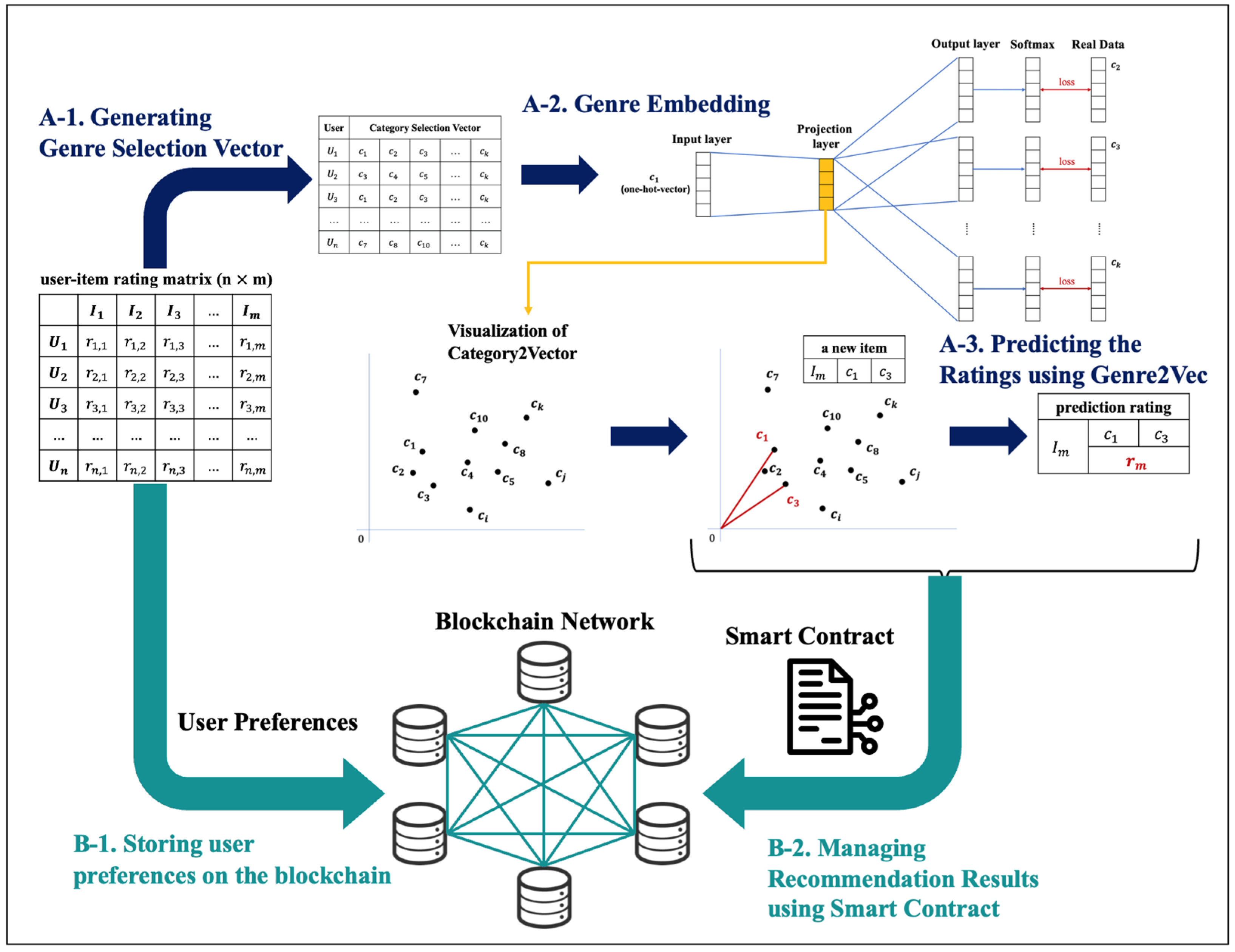
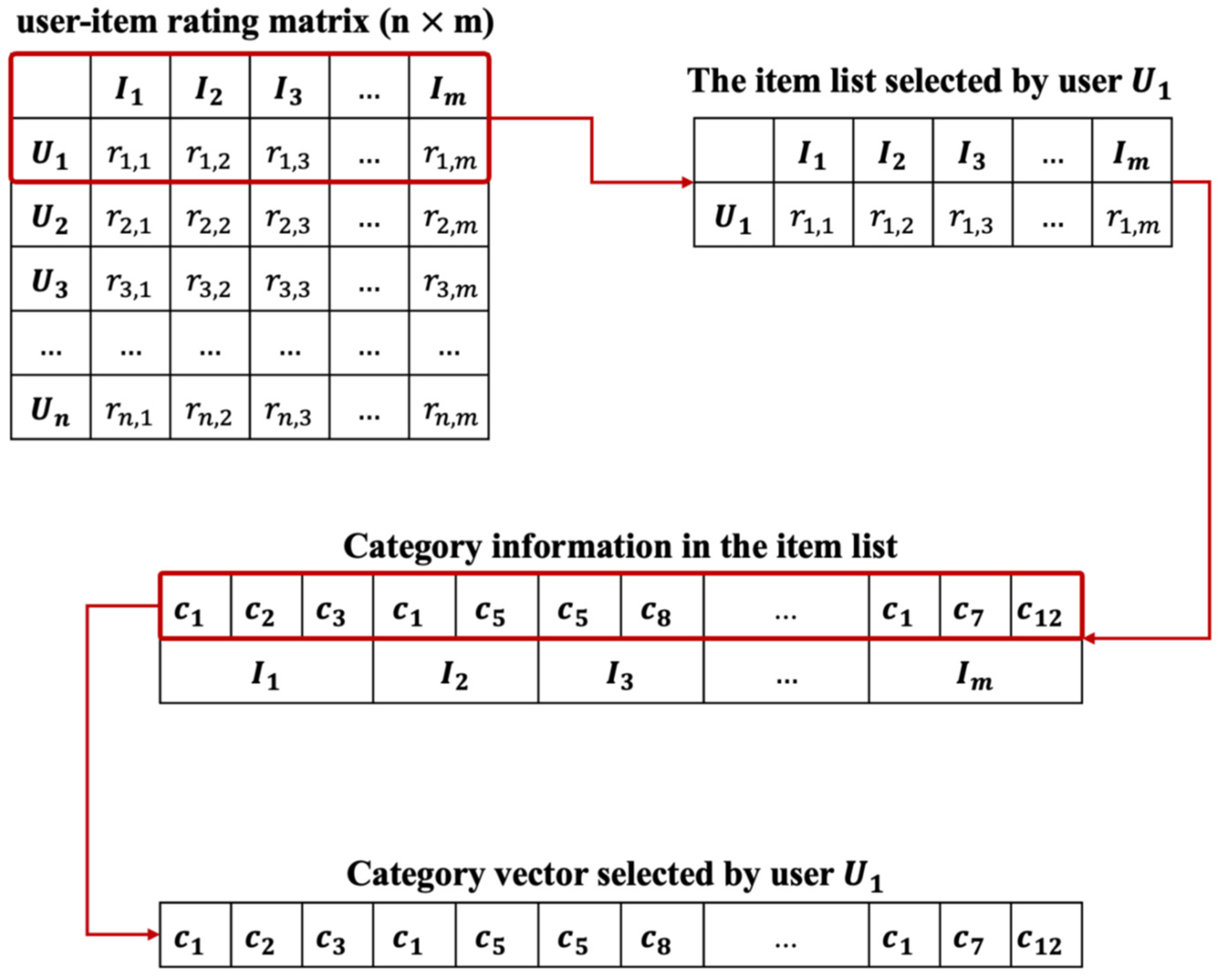
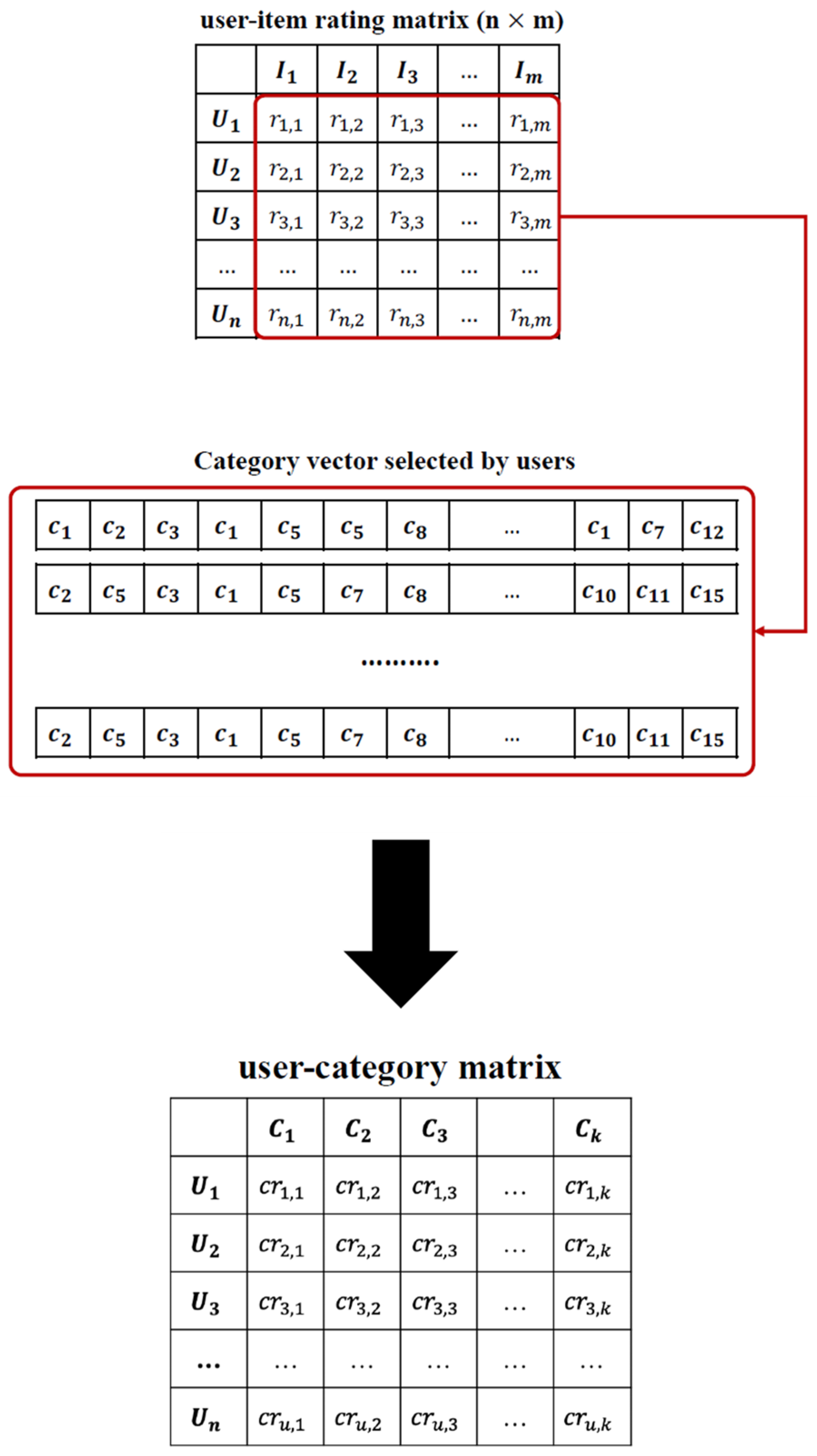

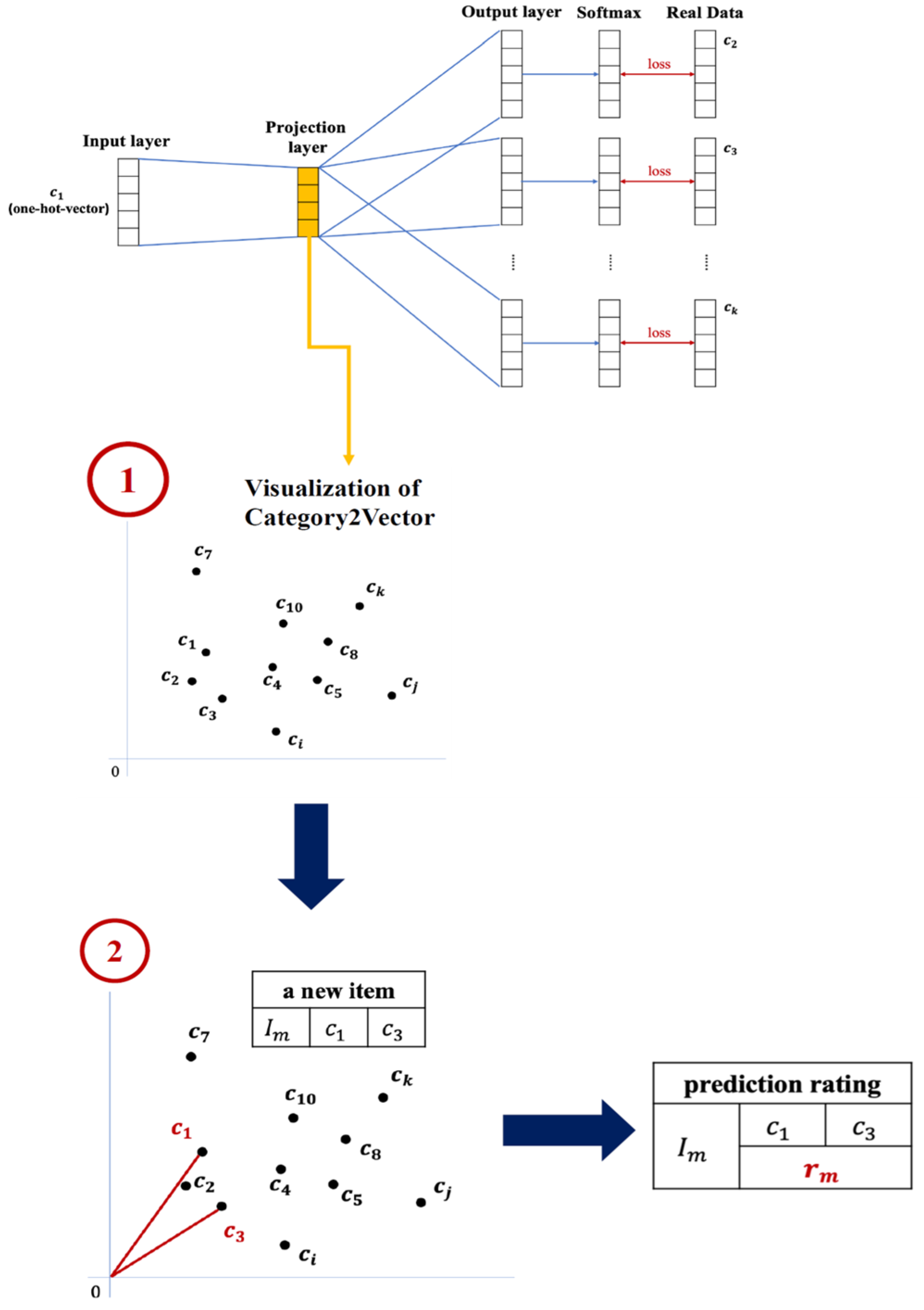
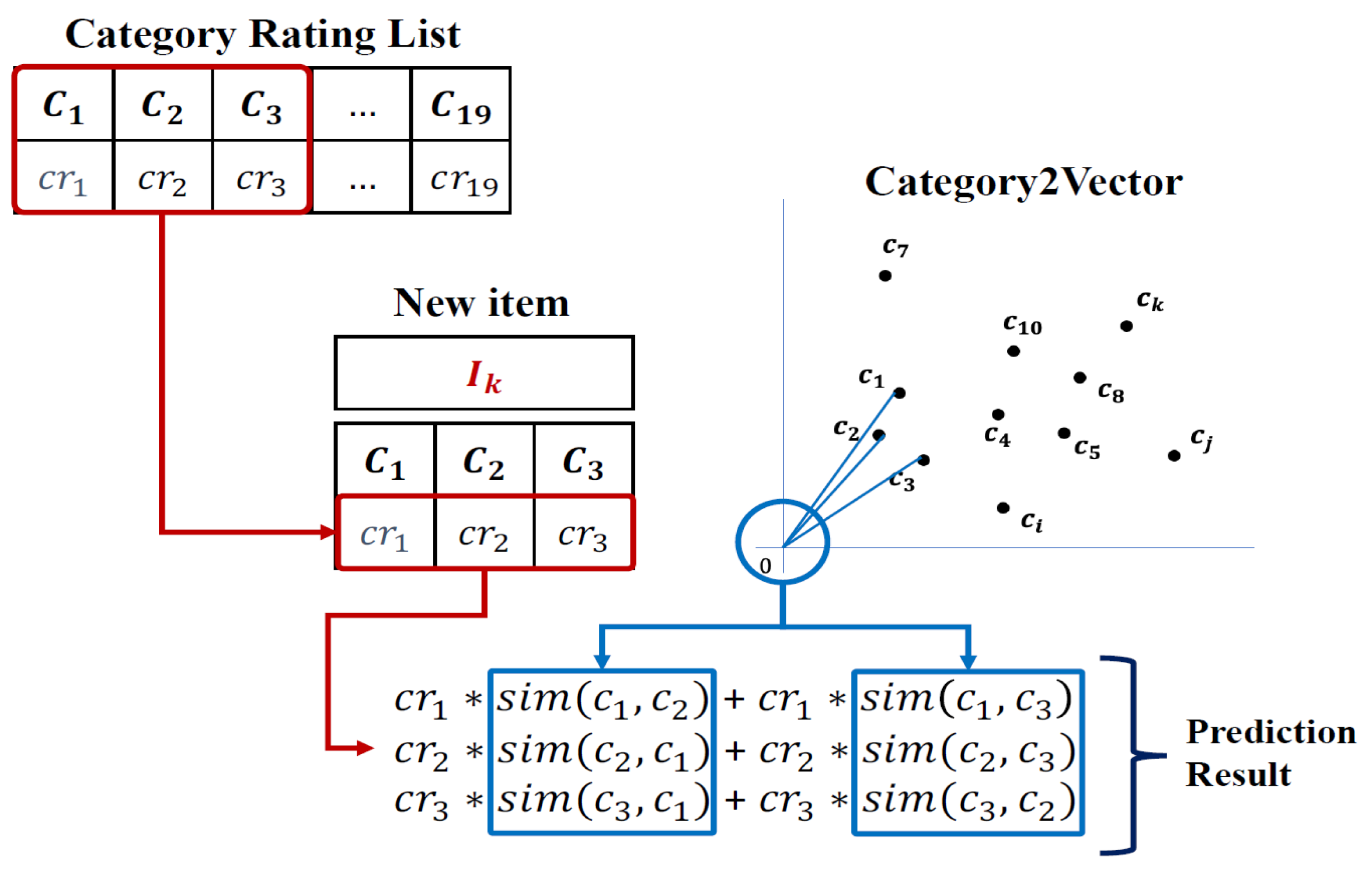
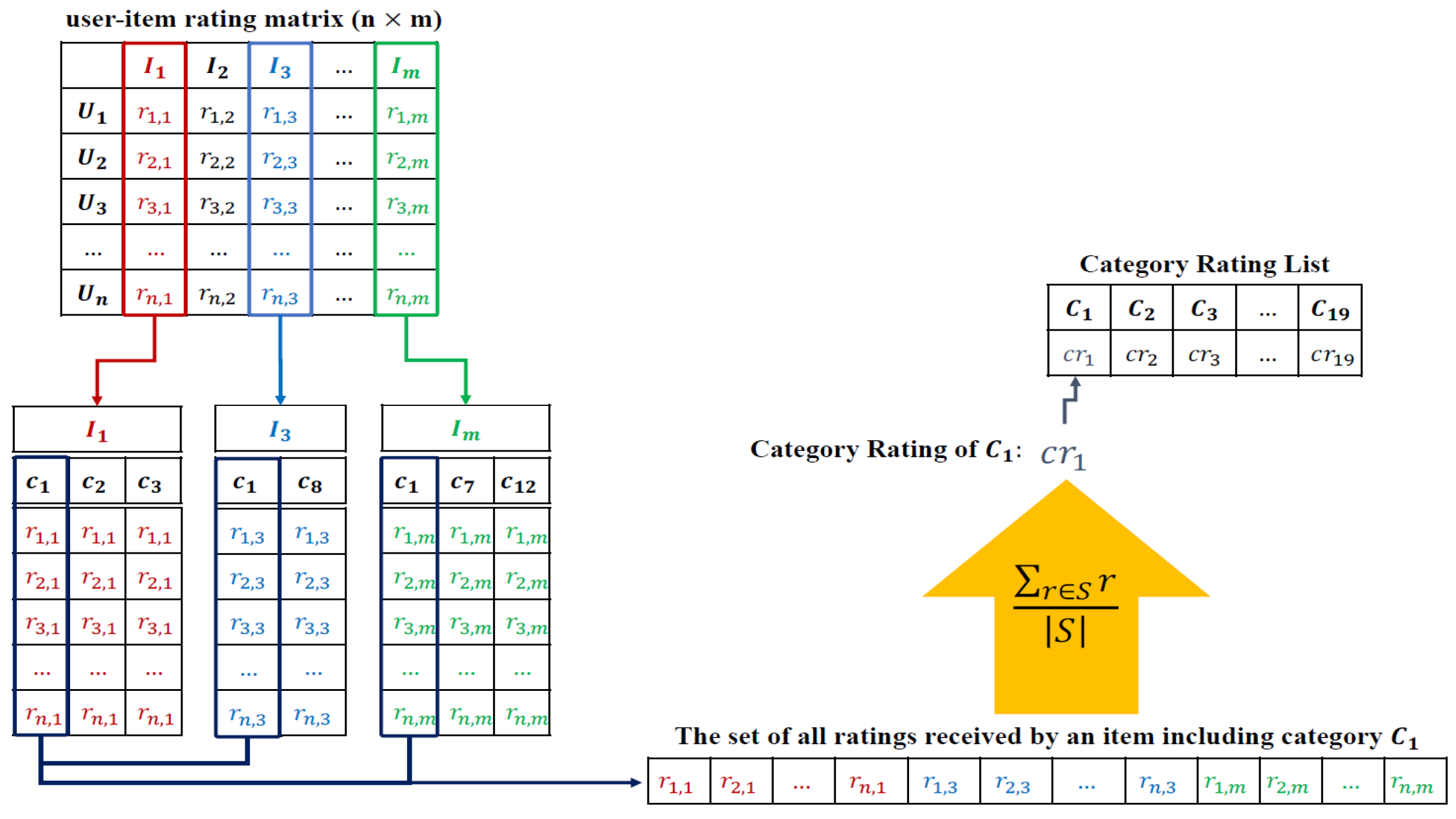
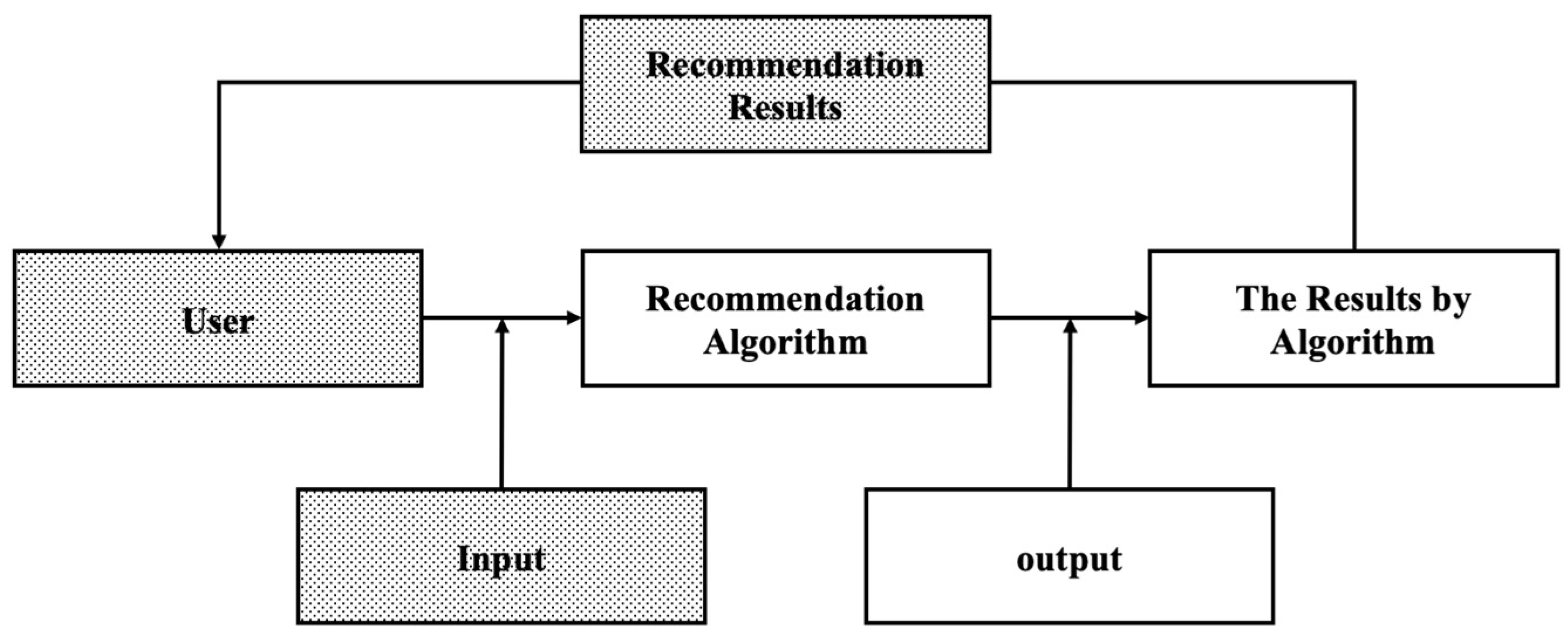
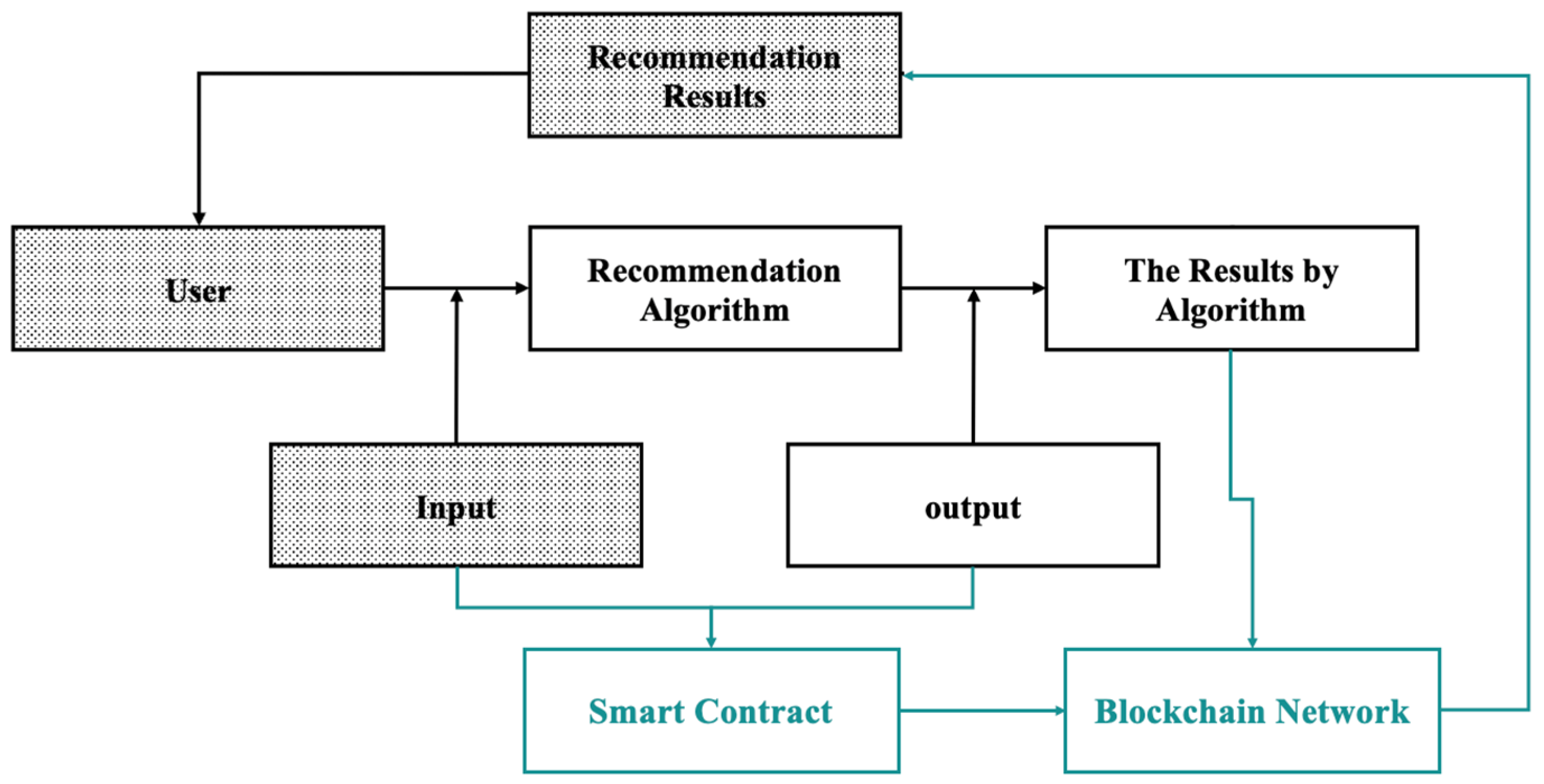
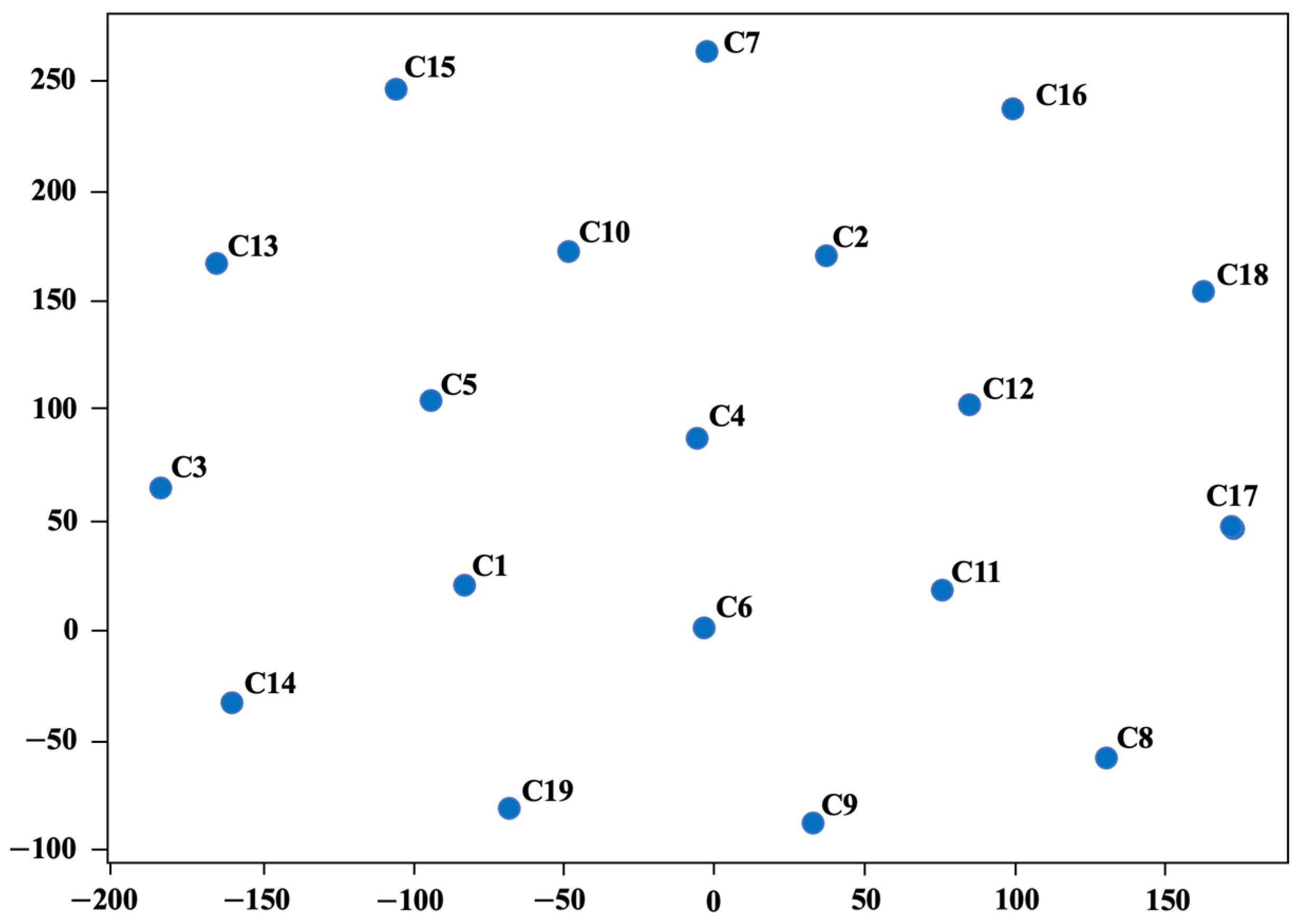
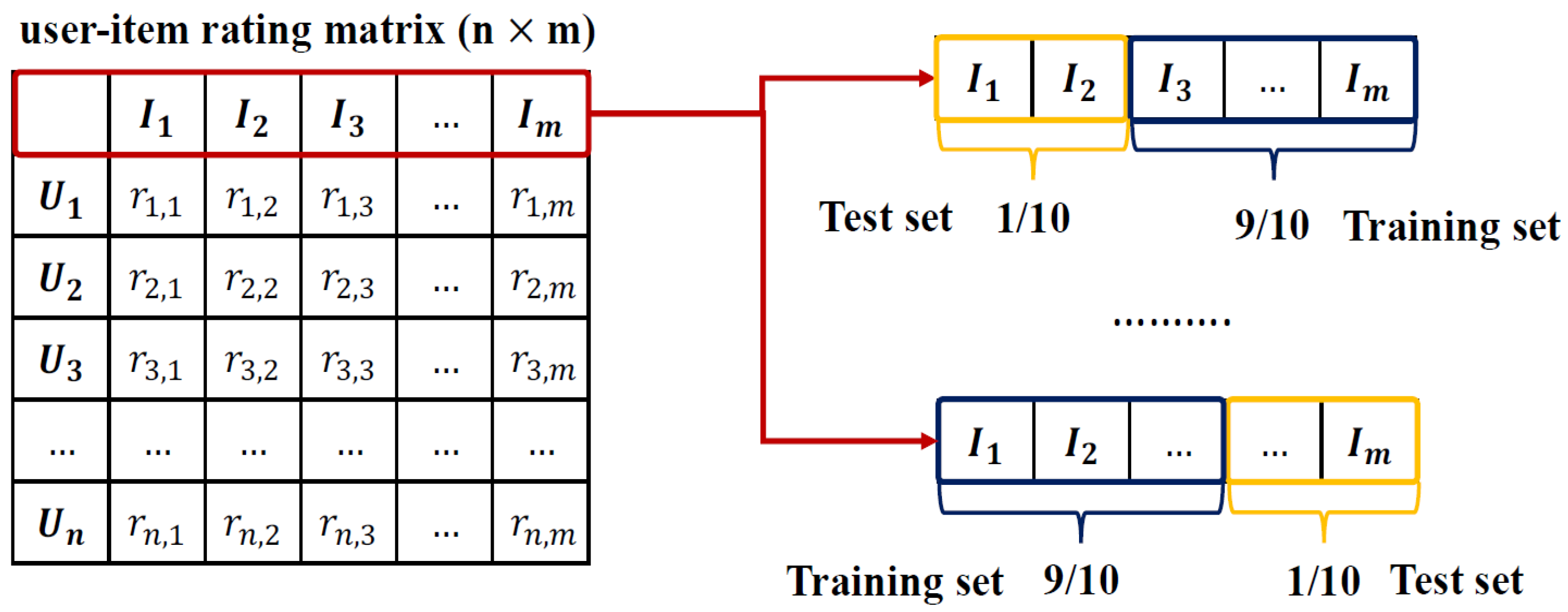
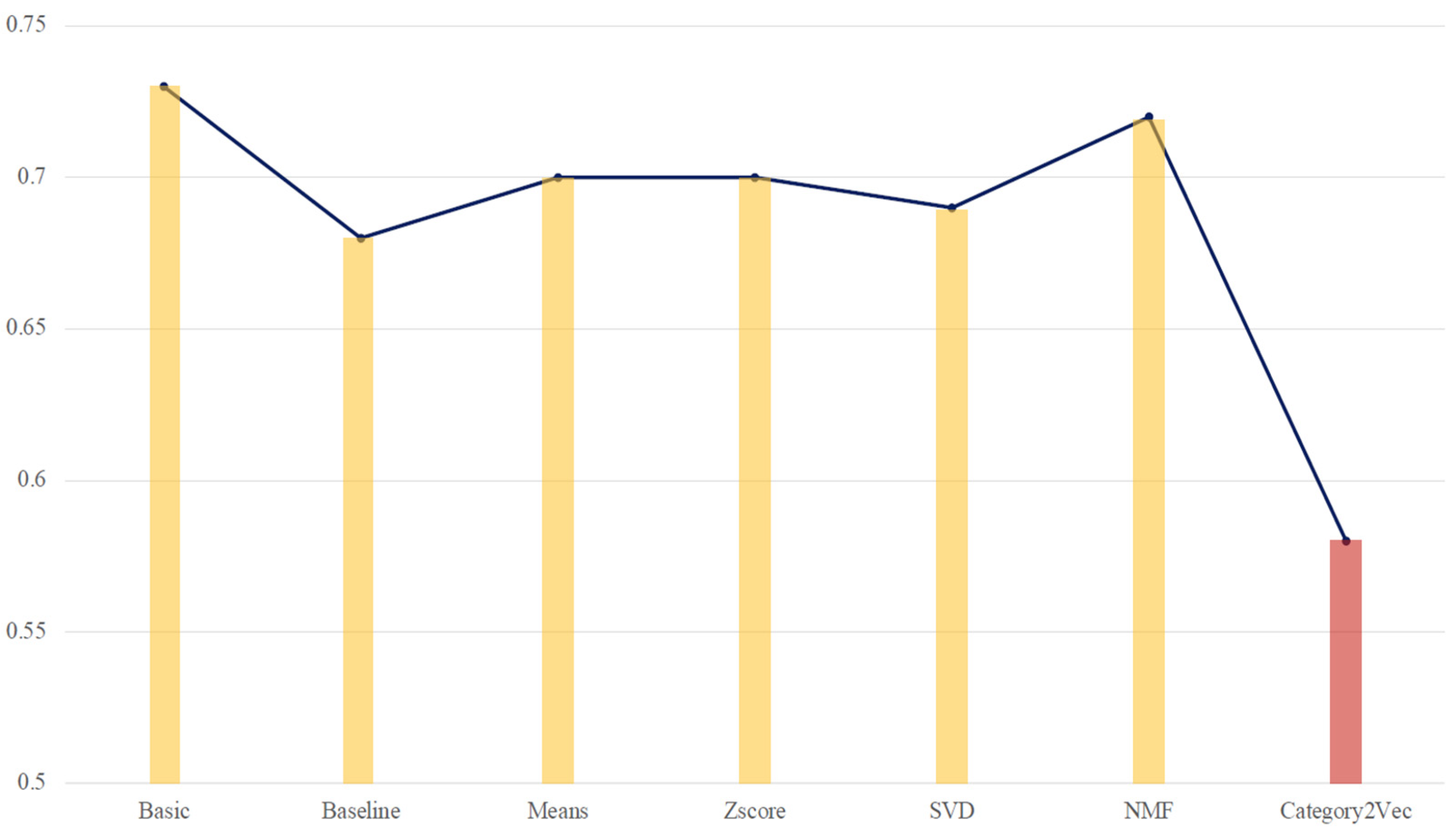

| Dataset | Attribute | Explanation |
|---|---|---|
| Movie dataset | MovieID, Title, Genre | 9125 movies |
| Rating dataset | UserID, MovieID, Rating, Timestamp | 100,004 ratings provided by 671 users |
| No | Genre | No | Genre | No | Genre |
|---|---|---|---|---|---|
| Action | Drama | Sci-Fi | |||
| Adventure | Fantasy | Thriller | |||
| Animation | Film-Noir | War | |||
| Children’s | Horror | Western | |||
| Comedy | Musical | IMAX | |||
| Crime | Mystery | ||||
| Documentary | Romance |
| Method | KNN (Basic) | KNN (Baseline) | KNN (Means) | KNN (Z-Score) | SVD | NMF | Genre2vec | |
|---|---|---|---|---|---|---|---|---|
| Fold | ||||||||
| 1 | 0.74 | 0.69 | 0.69 | 0.69 | 0.68 | 0.68 | 0.71 | |
| 2 | 0.74 | 0.69 | 0.69 | 0.69 | 0.70 | 0.69 | 0.73 | |
| 3 | 0.74 | 0.69 | 0.69 | 0.70 | 0.69 | 0.69 | 0.73 | |
| 4 | 0.74 | 0.68 | 0.68 | 0.70 | 0.70 | 0.68 | 0.71 | |
| 5 | 0.73 | 0.68 | 0.68 | 0.70 | 0.69 | 0.69 | 0.72 | |
| 6 | 0.74 | 0.68 | 0.68 | 0.70 | 0.70 | 0.68 | 0.73 | |
| 7 | 0.74 | 0.68 | 0.70 | 0.70 | 0.69 | 0.73 | 0.51 | |
| 8 | 0.73 | 0.68 | 0.70 | 0.71 | 0.69 | 0.71 | 0.61 | |
| 9 | 0.74 | 0.69 | 0.69 | 0.70 | 0.71 | 0.72 | 0.67 | |
| 10 | 0.74 | 0.68 | 0.70 | 0.69 | 0.68 | 0.73 | 0.70 | |
| Average | 0.74 | 0.68 | 0.70 | 0.70 | 0.69 | 0.72 | 0.68 | |
| Stdev | 0.003 | 0.005 | 0.007 | 0.005 | 0.007 | 0.006 | 0.09 | |
| Method | KNN (Basic) | KNN (Baseline) | KNN (Means) | KNN (Z-Score) | SVD | NMF | Genre2vec | |
|---|---|---|---|---|---|---|---|---|
| Fold | ||||||||
| 1 | 0.96 | 0.91 | 0.90 | 0.90 | 0.88 | 0.93 | 0.83 | |
| 2 | 0.97 | 0.90 | 0.91 | 0.92 | 0.89 | 0.94 | 0.70 | |
| 3 | 0.97 | 0.90 | 0.91 | 0.91 | 0.89 | 0.95 | 0.67 | |
| 4 | 0.96 | 0.88 | 0.92 | 0.91 | 0.89 | 0.93 | 0.63 | |
| 5 | 0.95 | 0.88 | 0.91 | 0.91 | 0.88 | 0.94 | 0.61 | |
| 6 | 0.97 | 0.89 | 0.92 | 0.92 | 0.90 | 0.95 | 0.60 | |
| 7 | 0.95 | 0.89 | 0.92 | 0.92 | 0.90 | 0.95 | 0.65 | |
| 8 | 0.95 | 0.88 | 0.92 | 0.93 | 0.90 | 0.93 | 0.78 | |
| 9 | 0.96 | 0.90 | 0.91 | 0.92 | 0.92 | 0.93 | 0.89 | |
| 10 | 0.97 | 0.89 | 0.92 | 0.92 | 0.89 | 0.95 | 0.91 | |
| Average | 0.96 | 0.89 | 0.91 | 0.91 | 0.89 | 0.94 | 0.72 | |
| Stdev | 0.006 | 0.008 | 0.008 | 0.008 | 0.01 | 0.009 | 0.11 | |
Disclaimer/Publisher’s Note: The statements, opinions and data contained in all publications are solely those of the individual author(s) and contributor(s) and not of MDPI and/or the editor(s). MDPI and/or the editor(s) disclaim responsibility for any injury to people or property resulting from any ideas, methods, instructions or products referred to in the content. |
© 2023 by the authors. Licensee MDPI, Basel, Switzerland. This article is an open access article distributed under the terms and conditions of the Creative Commons Attribution (CC BY) license (https://creativecommons.org/licenses/by/4.0/).
Share and Cite
Kim, Y.E.; Choi, S.-M.; Lee, D.; Seo, Y.G.; Lee, S. A Reliable Prediction Algorithm Based on Genre2Vec for Item-Side Cold-Start Problems in Recommender Systems with Smart Contracts. Mathematics 2023, 11, 2962. https://doi.org/10.3390/math11132962
Kim YE, Choi S-M, Lee D, Seo YG, Lee S. A Reliable Prediction Algorithm Based on Genre2Vec for Item-Side Cold-Start Problems in Recommender Systems with Smart Contracts. Mathematics. 2023; 11(13):2962. https://doi.org/10.3390/math11132962
Chicago/Turabian StyleKim, Yong Eui, Sang-Min Choi, Dongwoo Lee, Yeong Geon Seo, and Suwon Lee. 2023. "A Reliable Prediction Algorithm Based on Genre2Vec for Item-Side Cold-Start Problems in Recommender Systems with Smart Contracts" Mathematics 11, no. 13: 2962. https://doi.org/10.3390/math11132962
APA StyleKim, Y. E., Choi, S.-M., Lee, D., Seo, Y. G., & Lee, S. (2023). A Reliable Prediction Algorithm Based on Genre2Vec for Item-Side Cold-Start Problems in Recommender Systems with Smart Contracts. Mathematics, 11(13), 2962. https://doi.org/10.3390/math11132962








